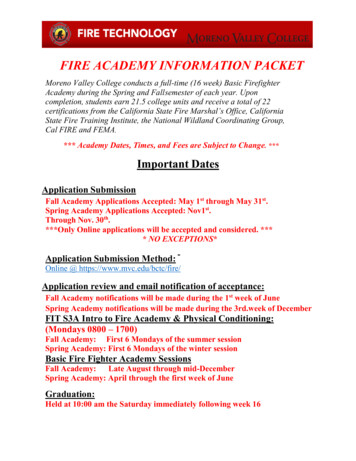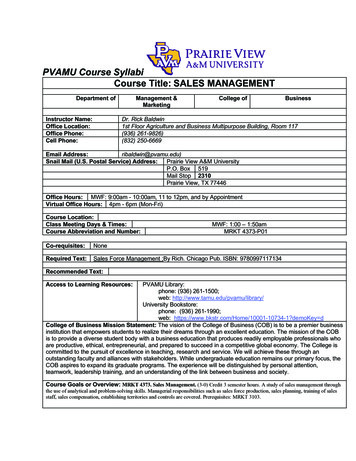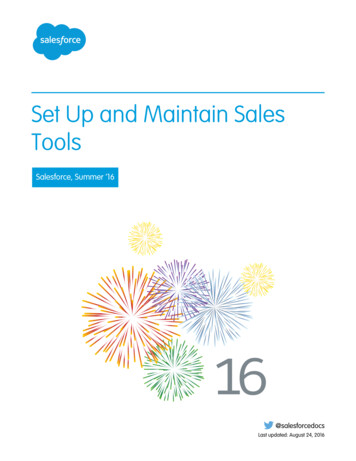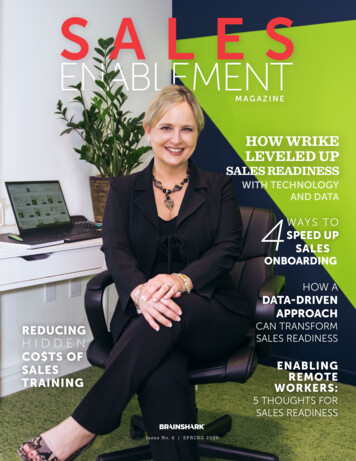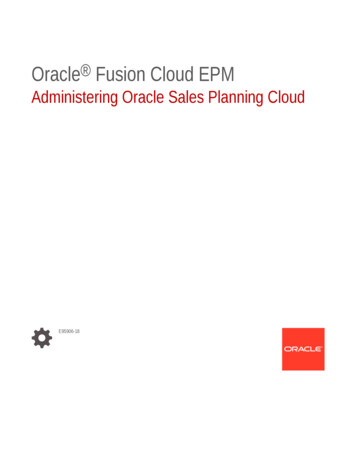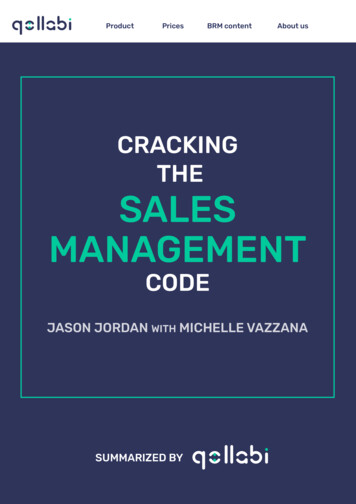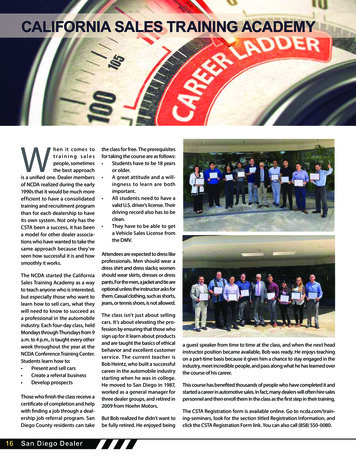
Transcription
CALIFORNIA SALES TRAINING ACADEMYWhen it comes totraining salespeople, sometimesthe best approachis a unified one. Dealer membersof NCDA realized during the early1990s that it would be much moreefficient to have a consolidatedtraining and recruitment programthan for each dealership to haveits own system. Not only has theCSTA been a success, it has beena model for other dealer associations who have wanted to take thesame approach because they’veseen how successful it is and howsmoothly it works.The NCDA started the CaliforniaSales Training Academy as a wayto teach anyone who is interested,but especially those who want tolearn how to sell cars, what theywill need to know to succeed asa professional in the automobileindustry. Each four-day class, heldMondays through Thursdays from 9a.m. to 4 p.m., is taught every otherweek throughout the year at theNCDA Conference Training Center.Students learn how to: Present and sell cars Create a referral business Develop prospectsThose who finish the class receive acertificate of completion and helpwith finding a job through a dealership job referral program. SanDiego County residents can take16San Diego Dealerthe class for free. The prerequisitesfor taking the course are as follows: Students have to be 18 yearsor older. A great attitude and a willingness to learn are bothimportant. All students need to have avalid U.S. driver’s license. Theirdriving record also has to beclean. They have to be able to geta Vehicle Sales License fromthe DMV.Attendees are expected to dress likeprofessionals. Men should wear adress shirt and dress slacks; womenshould wear skirts, dresses or dresspants. For the men, a jacket and tie areoptional unless the instructor asks forthem. Casual clothing, such as shorts,jeans, or tennis shoes, is not allowed.The class isn’t just about sellingcars. It’s about elevating the profession by ensuring that those whosign up for it learn about productsand are taught the basics of ethicalbehavior and excellent customerservice. The current teacher isBob Heintz, who built a successfulcareer in the automobile industrystarting when he was in college.He moved to San Diego in 1987,worked as a general manager forthree dealer groups, and retired in2009 from Hoehn Motors.But Bob realized he didn’t want tobe fully retired. He enjoyed beinga guest speaker from time to time at the class, and when the next headinstructor position became available, Bob was ready. He enjoys teachingon a part-time basis because it gives him a chance to stay engaged in theindustry, meet incredible people, and pass along what he has learned overthe course of his career.This course has benefited thousands of people who have completed it andstarted a career in automotive sales. In fact, many dealers will often hire salespersonnel and then enroll them in the class as the first step in their training.The CSTA Registration form is available online. Go to ncda.com/training-seminars, look for the section titled Registration Information, andclick the CSTA Registration Form link. You can also call (858) 550-0080.
In addition to the sales training course, NCDAalso has other seminars and workshops thatare offered throughout the year. Topics arechosen to help dealership employees betterdeal with regulatory compliance and tostrengthen their business skills. For example,past seminars have included: Annual legal and regulatory updates Essentials of vehicle registration F&I compliance Harassment avoidance training andeducation Health care reform Wage and hour updatesThe NCDA will continue to assess any newlaws that are passed and put togetherseminars and workshops that will helpassociation members to comply with anyrequirements by teaching them what theyneed to know and educating them aboutany required tools.Courses are taught atThe NCDA Conference & Training Center10065 Mesa Ridge CourtSan Diego, CA 92121Serving the Dealer Industryfor over 30 yearsEnvironmental Compliance: Review Of Hazardous Waste ManagementHazardous Waste Cost Recovery ProgramStorage Tank Compliance AuditHazardous Materials Release Response Plan(CERS)Spill Prevention Control & Countermeasures Plan(SPCC)Air Quality Management AuditSafety Management: Safety Inspection & Meetings (IIPP)Respiratory Protection ProgramSafety TrainingOnline Access to Safety Data Sheets (SDS)DOT Required Training for HazmatShippers & Receivers Training & Certification for Dealership EmployeesProviding a 24 Hour Support Phone Number AsRequired By DOTRepresentation in OSHA/EPA enforcement cases. PeriodicNewsletter on emerging EPA/OSHA issues as they impactdealers. See www.epaoshablog.comPENALTIES, FINES AND INCREASEDINSURANCE COST MORE THANCOMPLIANCEWe have Certified Safety Professionals on staff with decadesof experience in working with dealers.Considine & Considine is a full service public accounting firm offering professional andpersonalized services to business and professional practice owners in the areas of audit,taxation, accounting, estate and retirement planning.Sam Celly, BChE MChE JDCertified Safety ProfessionalMember OCADA, NCDA, SMCDA, AIHA444 West Ocean Blvd., Suite 1020Long Beach, CA 90802-4517Phone: 562.704.4000 Direct: 562.716.6100Email: sam@cellyservices.comLet us help guide your businessdevelopment.Philip Smith, CPAConsidine & Considine8989 Rio San Diego Drive, Suite 250San Diego, CA 92108619-231-1977 x103www.cccpa.comprs@cccpa.comSUMMER 2019 17
Franchise Advice & Litigation Labor & Employment Regulatory & Licensing Complex Litigation General Counsel Services Mergers & AcquisitionsAvoiding litigation when it’s possible. Protecting you when it isn’t.LO S A N G ELES ONTARIO SAN DIE GO S ACRAME N TO OAK L AN D scalirasmussen.comAV and AV Preeminent are Certification Marks used under license in accordance with the Martindale-Hubbell certification procedures, standards and policies.
INTERVIEWSBOB HEINTZDIRECTOR, CALIFORNIASALES TRAINING ACADEMYWhat is your industry background?I started in the automobile business in college, and I eventually beganselling cars. I worked as a factory representative for General Motors’Pontiac for about eight years, then fell back into retail. I owned a dealershipin a small town in Minnesota for 10 years. When you work in a dealershiplike that, you wear several hats.I was the general manager for a Cadillac dealership for eight years,worked for Bob Baker selling Infiniti for four or five years, and moved toseveral dealerships in North San Diego working for two brothers, theHoehns, for about 10 years. At that point, my wife’s health wasn’t good,so I retired even though I didn’t feel ready to retire otherwise.Why do you think training like this is important?Frankly, customers today are starving for service. Now that we arein the age of the internet and social media, we’ve gotten away fromservice, and people miss it. When they are in the market for a car, theywant to talk to someone who cares about them and listens to them. It’svery important to teach those who work at dealerships, or who planto work at dealerships, good people skills. They need to understandthe importance of service and excellence instead of mediocrity. Sellingcars is about building relationships with people, and giving them theexperience you would want if you were the buyer. What it comes downto is applying the golden rule. It works.What is your favorite sales topic to teach? Why?I guess my favorite sales topic is teaching students to understand thatpeople buy from people. The sales people are the most importantpart of the equation because they are the ones who talk the most tocustomers. They need to ask good questions, listen to what peopleare saying, and gain an understanding of their issues and why thoseissues matter. Treat people with enthusiasm and true interest. Thebuyer has the power to decide to buy a car, so we have to understandtheir wants and needs.As an example of this, you need to work with people based on theirwants and needs more than their budget. Too often sales people assumethings about a buyer too soon. Don’t engage them too soon about whatyou think they can or can’t afford. Hear what they want and need. If itis out of line with their budget then you can make adjustments later inthe process to what that budget is. But work with them based on theirneeds and wants, not what you think they have the ability to pay. Oncein a while you will make a mistake, but you can adjust later to whateverthat budget turns out to be.20San Diego DealerShare a bit about the career growth you haveseen from some of the students.There have been a number of success stories. The gentlemen who havebeen interviewed for this issue of the magazine have been examples of that. Anthony Benfatti had never sold cars, but then became the generalmanager of a Hoehn dealership in about six years. He was in oneof the first classes. Chris Boone is a young man who had never sold cars before, either,when he came through the class about three to four years ago. Nowhe is the new car sales manager at the Lexus San Diego dealership. When Michael Lee took the class, he impressed me with his incrediblework ethic. He is now a finance director at Lexus San Diego.During the weeks when I am not teaching, I make dealership visits. Everytime I make a visit, I see three or more people who came through thecourse. Not everyone goes into management. Some of them are doingvery, very well in sales, which can be a career in itself.One of the greatest satisfactions for me is to walk into a dealership andsee people who are succeeding and excelling as sales people or in otherroles within the dealership because they understand the importance ofcustomer service. They succeed quickly because of that understanding.Working at a dealership is a great career opportunity, financially andpersonally. Those who choose to make a career working at a dealershipcan take pride in serving others.What is the value and importance of industrytraining as offered through the CSTA?A lot of people offer ongoing training programs throughout the industrythat are similar to the CSTA, but the CSTA is particularly outstanding.There is a strong correlation between athletics and selling. Athleteshave to hone their skills and practice. It is the same thing in selling. Salespeople need to find someone to role play with so they can continuallygrow and improve their communication skills. That’s why we do roleplaying in the class. I teach students that making a good first impressionis important for making a sale, and then we role play on how to greet acustomer properly. Students learn how to be professional and how togive people a good experience.Selling is a process. I am a big believer in process because I’ve seen thatknowing what to do next gives people confidence. The idea is to leadpeople. You don’t tell your way to a sale, you ask. It’s important to askgood questions that give you a direction for what the customer is hopingto achieve with their dollar, and then listen to what they’re telling you.
Some sales people think too much about their ownagenda instead of the customer’s agenda.How do dealerships benefit from thiscourse?I have been primarily in management most of mycareer. The retail business is fast-paced, and there areall kinds of distractions. Managers get so engaged intheir many responsibilities that they’re not able to doany kind of concentrated training with employees.Even the managers who want to train find that theycan’t. They get pulled in too many different directionsbecause of their different responsibilities.We put people in a class for four days and give them a goodfoundation. Once they have the foundation, they can buildon that foundation and continue to train themselves bygoing to YouTube, social media, and books. The tools arethere to help people keep themselves sharp. There’s a lotto be said about self-motivation and having the initiativeto be the best. But first, you need a basic understanding ofhow to be more successful by understanding what is reallyimportant in sales: giving people the kind of experienceyou would like to have. Once they understand that partof it, you can encourage them to work on their skills andimprove, and also encourage them not to be complacent.Being complacent is when they get into trouble.Based on your background withthe CSTA, what are your best threepieces of advice to someone entering this industry as a career?1.Become a student of the business. Understandthat it is a career, not just a job.2.Learn discipline. You need to discipline yourselfand learn how to focus and use your time wisely.It’s not just the hours you work; it’s what you dowith the hours.3.MICHAEL LEEMichael Lee, a former CSTA student, isnow a finance director for Lexus San Diego.How did you get into the autoindustry?I spent almost 25 years in the restaurantbusiness, which is another customer servicebusiness. When I got out of the restaurantservice business, however, I still wanted tobe in an industry that focused on customerservice. A friend suggested the auto industryto me because it had better hours, betterpay, and I would still be able to interactwith customers.The biggest impact that my backgroundin the restaurant business had on me wasthe hospitality part. I would greet customers warmly, and I treated people like theywanted to be treated. Some people toldme I was a breath of fresh air because ofthe honesty and warmth. This business isnot known for that.What do you like about it?Think of yourself as a business within a business. What makes this a careerYou are an employee but you have the opportunity choice?to build you own business. That understandingchanges how you approach things. It motivatesyou to continually learn and improve.What trends do you see happeningin the auto industry in the next fiveyears? How will industry training help?This is absolutely a career for me. OnceI go into a field, I am committed to it.That’s just me. I like the hours and theinteraction with customers, and the payis good.Who suggested the CSTAto you?It was a requirement when I went to workat Hoehn Motors.Was there an “aha” momentabout a topic, or learningsomething new, that youdidn’t know before?I was new to the industry, so everythingwas new to me.Would you recommend theCSTA? Why?Absolutely. The class gives you a lot of insightand teaches a lot of fundamentals, such asterminology and learning basic one-on-oneautomobile sales. It gives you informationthat you wouldn’t get at a dealership rightaway, although you might learn it over time.The class accelerates your training.How has this trainingimpacted your career?It helped me in the beginning because it gaveme a foundation to start from. I learned thebasics: how to do an interview, walk through,test drive, and all that. It helped me becomea good sales person. Once I was working, Ihad a mentor who taught me, which is howI got into finance.Industry training is going to continue to be helpfulbecause the basics of the business are not going away.People still buy from people. Even though we have socialmedia and many different ways of communicating,people will still drive farther for a great sales experience.I don’t see that model changing for the foreseeablefuture. Providing a great sales experience will continueto be important. Yes, you can buy a car online withoutstepping into a dealership and have it delivered to yourhome, but people like personal interactions. They wantto see, smell, and sit in the car they’re going to buy.SUMMER 2019 21
CHRIS BOONEChris Boone, a former CSTA student, is now the new car sales managerat Lexus San Diego.How did you get into the auto industry?I have been in the auto industry for about five years. Before this, I wasgoing to college and studying physical therapy, which is completelydifferent than what I am doing now. Private institution schools are prettyexpensive, though. I took a break to earn money. Friends and familyrecommended selling cars so I went into a dealership that my aunt hada connection to. That was Mazda Escondido.What do you like about it? What makes this acareer choice?I like that this is a people business. In the end there are a lot of businessplatforms that deal with people, but this is especially forward facing. WhatI mean by “forward facing” is that it is a positive field to be in. You arethe direct connection between a customer who is looking to purchasesomething and the car they want to buy. You are the person who canbuild the value of that car for them and show them why the product issuperior. It is pretty cool to have the ability to do that. I like the humanaspect of this industry, learning to work with people in different ways.Who suggested the CSTA to you?Gary, who was my general manager at the time, wanted me to attendthe course just to get my feet wet. It provides a really good baseline forpeople who have never been in the business before. That was certainly me.Tell us a little about the training, the process, andthe time commitment?It was about two or three days of training, from 8 a.m. to almost 4 p.m.Bob was always there first thing and he led us through the platform thatthe car industry is built from, and then he taught us the lingo for the carbusiness, such as what an up is.Bob also taught us what the business models are, and how to approachpeople. He really gave us just a good base platform for understandingthe car business. For example, he taught us how to introduce ourselvesto customers. He also taught us super basic questions to ask.People who have been in the industry a long time know it can getfrustrating. Bob’s approach was humble and simple; you are there tohelp the customer find out if the product is right for them and thenconvince them (if it is a good fit) that they should make the purchase.Bob also taught us how to thrive or succeed inside the dealership andhow to understand its dynamics.22San Diego DealerWas there an “aha” moment about a topic, or learning something new, that you didn’t know before?There are a lot of aha moments in our industry. When you do your firstwrite-up with a customer, you sit down with them and then you talk withyour manager. The manager teaches you what to do and say. Once you aredone talking with your manager, you go back out to the customer and dothe best you can to repeat what was said to you. While you may not sayexactly what you were told, you get the general message across. You learnto say things in your own way and begin to create your own routine. Then,before you know it, you are using these word tracks you have developedwith customers and instead of having to go back to your manager to repeatit, the customer understands what you are telling them right on the spot.Those aha moments don’t ever really stop, because people’s logic andwhat they will do always surprises you. As a new person, your managersteach you the right language to use that will overcome a customer’sobjections. You begin to trust that approach and understand why itwould make sense to the customer, so you say things and it works.When you start, you don’t know how to build value. Bob and these managers teach you basic phrases and later you discover why those phrases work.Would you recommend the CSTA? Why?I would recommend it a hundred percent. First, it is free for most of thosewho are sent by a dealer as long as they are local. This is the case because theCSTA is connected to so many dealerships. Second, it has a huge network ofdealers who could hire you. It helps you understand more about the industry,which means you can decide if you want to try this kind of work. There is ahuge market in San Diego, and dealerships are always looking for people.If you decide to take the class, you can be looking for a job within a week.After I went to the class, I stayed at Mazda. In fact, I kept working for themfor five years. I’ve changed dealerships, but I work for the same automotivecompany, the Penske Automotive Group. I’ve stayed local to the San Diegomarket and have moved from sales, to finance, and to my current position.How has this training impacted your career?I took the class and then I got into the business. Everything took offfrom there. I was unclear about some of the things Bob talked about,but I began to understand everything he said as I began working. Thatprocess was reassuring because he gave me a map of what to expect.The class helped me understand what my role was in the dealership. Thetools that Bob gave us in that class are fundamentals that go throughoutthe industry. At the time, I wasn’t sure how those fundamentals wouldbenefit me, but as I began my career it quickly became clear.
ANTHONY BENFATTIAnthony Benfatti, a former CSTA student, is now the GM of JaguarLand Rover Carlsbad.How did you get into the auto industry?Before working for a dealership, I worked in a lateral type of business forseven years. I started as a ticket writer at a carwash in North County, androse to the pinnacle of that operation as manager and head of operationsfor a whole group of car washes. But it is pretty monotonous at a car wash.I wanted a change so I could do something that was more exciting andimpactful. I wanted to be more professional, to wear a suit and tie, andto do something that was more adventurous than what I had.Several family members were already working for dealerships. Myuncle, Sean Conner, started out selling cars and was the sales managerof Hoehn Porsche. He’s now the executive general manager for HoehnMotors. My younger brother, Bryce, who is also a graduate of CSTA, wasselling cars for Hoehn Acura. Sean and my brother both encouraged meto consider working for a dealership.What do you like about it? What makes this acareer choice?I love the challenge of working as a general manager at the dealership.Every day offers so much opportunity personally and professionally.I work in a brand where I get to help people buy their dream cars, Ihelp employees reach their personal and financial goals, and we do alot to support the community, such as contributing to charities. I getto meet so many interesting, diverse people. I talk to everybody fromthe worker at the car wash to the billionaire. The common ground isour interest in cars.If you want to excel, there’s lots of room to grow and develop. The industryhas a lot of growth and potential because it offers different job roles forevery personality type. You can work in parts, service, or sales. Things arealways changing and evolving. We are always seeing new technology,new processes, newer models, and state-of-the-art facilities.Who suggested the CSTA to you?Uncle Sean knows Bob Heintz and recommended CSTA as a great startingpoint to get insight and as a place to decide if I wanted to go further.The class was a great segue into the industry.Tell us a little about the training, the process, andthe time commitment?The class is free, so I exchanged just one week of my time to decide ifworking at a dealership was what I wanted to do.The class offers a perfect training process. It’s an opportunity to gatherInformation. You learn about the dealership model, the sales process, andwhat to expect when you join a dealership. It provides a good overviewof the new role you will play, and gives you the basic knowledge you willneed so you can feel confident the first day you start.Was there an aha moment about a topic, or learning something new, that you didn’t know before?I think I had an “aha” moment for myself when I heard Bob Heintz talkabout this guy, Byron Brown, a top-performing salesman. Byron didn’thave an automotive background, but he was a huge success anywayand he became a legend in the automotive field. Byron was the numberone sales person for month after month after month. Hearing aboutByron was exciting. I knew I needed to get into this industry and takeon this career.Byron is retired now, but I interviewed him during the time betweenfinishing the class and starting work. I felt like he was passing the batonto me. He told me that dealerships give you everything you need to besuccessful. There are very few careers when you can be given all thosethings. All you have to do is make your schedule, and then put in thetime and the effort. It becomes your own business, in a sense. I will neverforget what he told me.I work now in the same group Byron worked at before he retired. I go tomanagement meetings at the Mercedes Benz stores. These businesseshave been picking sales of the month for 20 years. About a third of theplaques on the wall have Byron’s name on them.Would you recommend the CSTA? Why?I would definitely recommend taking the CSTA class to everyone who isconsidering a career in the automotive world. The class is very insightful.A lot of locations don’t offer potential employees anything like this. Sinceit is free, the only commitment is really just your time. It’s a motivatingclass because it takes a lot of the unknowns and puts them in front ofyou. It addresses them. You walk out feeling like you know what you aregetting yourself into.How has this training impacted your career?CSTA was really what lit the fire in my career. That week-long commitmentgave me a strong foundation, and I felt compelled to keep going. I cameout of the class feeling confident and motivated. I knew I wanted to dothis kind of work and I really enjoyed the experience. Everything I’vedone professionally since then has sprung from it.SUMMER 2019 23
8989 Rio San Diego Drive, Suite 250 San Diego, CA 92108 619-231-1977 x103 www.cccpa.com prs@cccpa.com Let us help guide your business development. Sam Celly, BChE MChE JD Certifi ed Safety Professional Member OCADA, NCDA, SMCDA, AIHA 444 West Ocean Blvd., Suite 1020 Long Beach, CA 90802-4517 Phone: 562.704.4000 Direct: 562.716.6100


